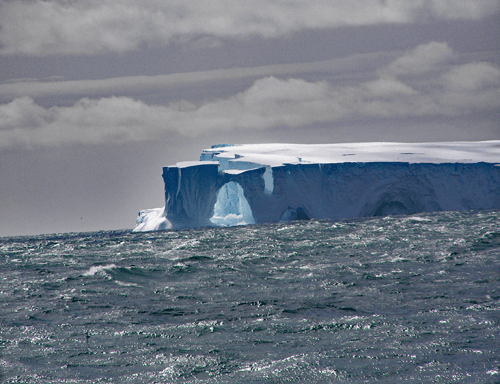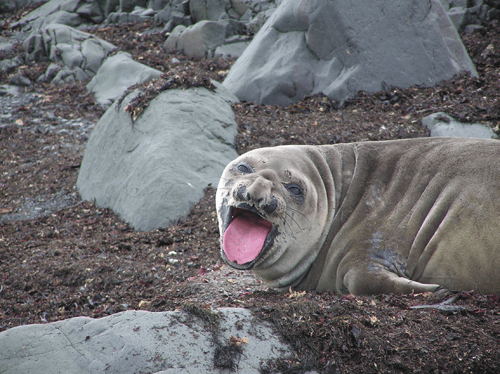Antarctica
Drake Passage and Beyond
At least once a year, Ginny and I sit down and compare each of our “top 5 travel destinations.” Every time we do this, Antarctica appears on both of our lists. In fact, Antarctica has been #1 on both of our lists since we visited in 2003. Although you’ve heard the expression, “you had to be there” before, I will try to describe some aspects of our adventure here, even though it is almost impossible to describe.
Ginny, our son Michael, and I boarded the Academik Ioffe in Ushuaia, Argentina en route home from spending three months in South Africa. Getting to Ushuaia from Cape Town was non-trivial; it required three flights: a 10-hour flight on Malaysia Air from Cape Town to Buenos Aires, a 3-hour flight from BA to Rio Gallejos, and a 1-hour flight from Rio Gallejos to Ushuaia. We were exhausted, but when we saw Ushuaia, it was all worth it! What a beautiful town and backdrop.

Our ship (АКАДЕМИК ИОФФЕ in Cyrillic) was in the harbor getting provisioned for our upcoming voyage. On some websites, this ship is called the Peregrine Mariner or the Marine Adventurer. I suspect the reason is to not scare away some tourists who could be afraid to be on board a Russian ship. However, anybody who gets on can easily read the name of the ship on its bow.

The Ioffe is a 383’ Russian research vessel with a maximum speed of 14.5 knots. It has a maximum capacity of 100 passengers (it carried 50 on our trip) and carries a crew of 65. Ginny and I had one cabin and we shared a bath with Mike who was in an adjoining cabin. The ship features an internal 450 ton water-ballasted stabilizer system that keeps it amazing stable, even in heavy seas. We were told during the briefing that the stabilization system is necessary so the ship can do research on Arctic and Antarctic Ocean seabeds from a geo-stable surface platform; however, from our passenger perspective, stability contributed greatly to our comfort. The ship also has bow and stern thrusters, which I had never seen before. The captain showed how he could use these to reposition either end of the ship to the port of starboard; at one point during the trip, he even demonstrated how he could use the bow thruster to redirect an ice¬berg that was meandering slowly toward the ship while we were at anchor.
Ginny and I are not fans of the typical “cruise scene.” But this was ideal. The meals were all served buffet style and we all dressed casually. Ah yes!
For the first 3 days, we cruised across Drake Passage. The crew said it was unusually calm, and in fact called it Drake Lake. However, Mike and I were the only passengers aboard who ventured out on deck; we had to hold on tight, especially when climbing the ladders to the highest deck, or we would have been blown overboard. The waves were crashing over the top of the ship. Here is Mike on the highest deck. Not for the faint of heart, the weak-armed, or weak-legged.

On the third day, we saw our first iceberg. How grand! It was 10 times larger than our ship; one end looked like a cathedral.

For the next 5 days, we slipped in and out of passages of the Antarctic Peninsula, viewing an ever changing panorama of vistas, and making landfall around twice a day. Here is the entry to Lamaire Channel; it reminds me of a scene ideal for a jigsaw puzzle.

Here are photos I snapped of blue-eyed cormorants and one of thousands of Gentoo penguins I saw.


One highlight of the voyage was the opportunity to camp out over¬night on the mainland of Antarctica. About 30 of the 50 passengers participated. We were each given a bivy sack and sleeping bag; no tent. We were shuttled to land in the usual zodiacs around 10pm, and instructed on how to clear away the top layer of snow before laying out our sleeping materials. Here is what our sleeping area looked like.

I was wearing around 6 layers of clothing. I shed the outer 3 layers when I turned in, and laid them beside my sleeping bag (you can see one of those layers in yellow in the above photo). That was actually a mistake because during the night when I needed to use the toilet, these garments were frozen solid and I could not put them back on. Instead, I should have shoved them inside my sleeping bag with me. We were told that if we become cold or wanted to return to the ship anytime during the night, all we had to do was awaken the crewmember who was sleeping in a tent near us; he would be happy to motor us back to the ship in the zodiac. Because the sun was up all night, you could wake up at any time and feel like it was morning and that you had slept all night. Mike actually returned to the ship around 4am; Ginny and I slept until around 8am. It wasn’t a bad night’s sleep.
We spent much time with Gentoo, Adelie, and chinstrap penguins, the latter being my favorite by far. On one occasion, Ginny and I went for a hike and left Mike at the shore. When we returned, he was lying down on the snow with three chinstraps standing on him looking at him askance. Here are two photos of chinstrap penguins. The first shows a chinstrap incubating an egg on a nest; no external signs distinguish male from female and they share the parenting responsibilities; as a result, I do not know if this is mom or dad. The second shows a very proud chinstrap; he seems unaware that another chinstrap had defecated on his chest. Both were taken at Paradise Harbor.


Finally, here is my favorite wildlife photo from Antarctica, a female elephant seal that posed angrily for me on Aitcho Island.

© Alan M. Davis
If you enjoyed this story, consider buying my book,
Unusual Latin America (and Antarctica): Traveling on the Edge. It contains this and twelve other stories of our adventures in Central and South America as well as Antarctica.
Contact Him
To contact him at Offtoa:
email: adavis(at)offtoa.com
phone: 719-232-1938 (cell), 719-425-8858 (office)
To contact him for other reasons:
email: aldavis171(at)gmail.com
phone: 719-232-1938 (cell)